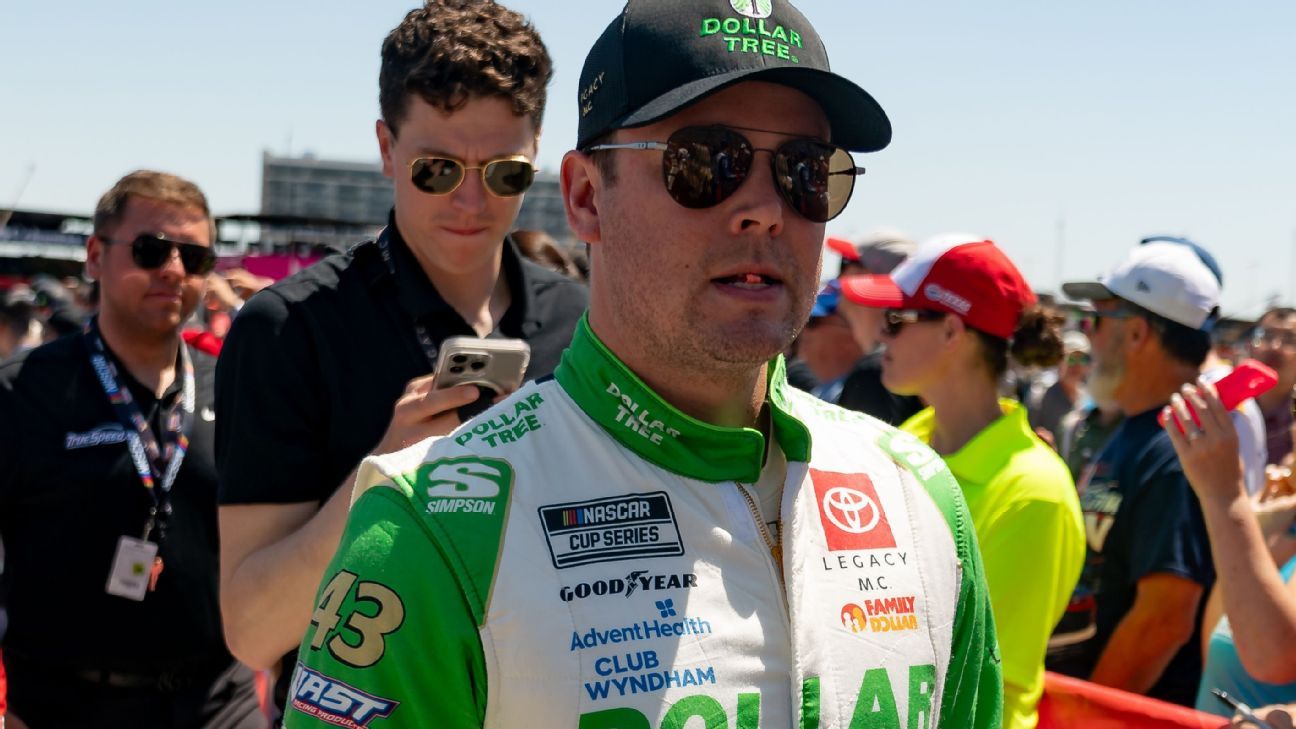
DOVER, Del. —
It didn’t take long for a harsh reality to sink in. Jones returned to his motorhome and excruciating pain shot through his back. He needed a second visit to the care center and a trip to the hospital, where he learned the grim news: Jones suffered a compression fracture in a lower vertebra that will sideline him from Sunday’s race at Dover Motor Speedway.
“I’ve never broke a bone in my life,” Jones said Saturday at Dover. “I didn’t know what that would feel like.”
Jones’ soreness has started to fade. He has limited range of motion, and the three-time Cup race winner aches when he sneezes. But beyond the medical update, Jones and Legacy co-owner Jimmie Johnson came with an additional message: The medical team at Talladega did its job when it examined Jones, even if the seriousness of the injury was not detected until later that night.
“I think the care center reacted perfectly,” Johnson said. “It was not much he could have done differently in that moment. I think everybody did a great job.”
The trip to the care center — and even the post-exam interviews — is as much a part of a NASCAR weekend as the waving of the checkered flag.
The NASCAR rulebook spells it out: “If a vehicle sustains damage from an accident or contact of any kind and must go behind the pit wall or to the garage area, whether under its own power or not, the driver must immediately proceed to the Infield Care Center by either ambulance or other vehicle as directed by the safety personnel or a NASCAR Official.”
Most trips are fairly routine. Drivers are in and out and ready to get behind the wheel the next week.
Jones’ diagnosis was a bit trickier.
After his two care center visits, Jones needed an exam hours later at UAB University Hospital in Birmingham, Alabama, for further evaluation and testing. He then returned home to North Carolina on Sunday night and met with specialists in the Charlotte area, where it was determined that Jones suffered a compression fracture in a lower vertebra.
The progression raised some questions about the process. Among them, why wasn’t the back injury noticed the first time at the care center?
Jones absorbed some blame.
“They poked and prodded all over me like they normally do,” Jones said. “I said everything felt OK. I told them multiple times it was feeling just like a muscle strain to me.”
Jones did not have X-rays on his first visit to the care center. Talladega care center nurses told Jones when he was released to come back if he felt worse. When his pain heightened, Jones returned for a second visit, and X-rays were administered.
The care centers at NASCAR tracks are largely staffed by local emergency physicians, nurses and specialists and are often affiliated with a nearby hospital.
“NASCAR has one of the strictest qualifications, which we’ve held up for years now, in who is qualified to see anybody under the NASCAR umbrella in terms of the initial contact,” said Ryan Stanton, medical director of the AMR NASCAR safety team. “Some of those care centers will have access to X-ray capabilities. Most have some form of ultrasound available, if not all of them.”
While signs of a concussion or other head injuries is sometimes the pressing concern, Stanton explained the initial exam is pretty much a standard physical. Drivers strip their firesuits to their waist, vital signs are taken, and they are given “a head-to-toe examination.” Special care is given if drivers show any symptoms of trauma.
“From a driver’s standpoint, if nothing is wrong, they want it to be out as quick as possible,” Stanton said. “Even though they requested the services, many of them don’t want to be there. I get it. They’re professional athletes. The last place they want to be on race day was in front of doctors and nurses in a care center.”
Drivers will undergo neurological testing, if needed.
“We can typically knock out this entire exam, which is very efficient, in about 5 minutes, maybe even less,” Stanton said.
And what about a driver who might be hiding any symptoms that could prevent him from racing?
“A lot of these tests that we do, you can’t fake your way out of,” Stanton said.
Jones took the brunt of the blow, a crash that would have been much worse without the sturdy cars and foamy barriers. NASCAR took the Toyota to its research and development center for additional study.
“I think NASCAR has gotten some of a bad rap this week, the Next Gen car gets a bad rap,” Jones said. “I think the car did its job.”
Corey Heim will substitute for Jones in the No. 43 Toyota, and there is no timeline for Jones’ return. Legacy also fields a full-time ride for John Hunter Nemechek. A seven-time NASCAR champion, Johnson drives only sporadic races, including Sunday at Dover, where he holds the track record with 11 victories.
Heim would sub again for Jones next weekend at Kansas, if needed. Beyond that, Johnson didn’t close the door that he could fill in for Jones.
“I’m feeling better and better every day,” Jones said. “I have an appointment next week and kind of will make a decision from there.”






